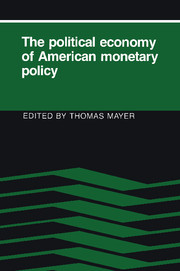Book contents
- Frontmatter
- Contents
- Preface
- List of contributors
- 1 Introduction
- 2 Studying the Fed: toward a broader public-choice perspective
- 3 The Federal Reserve reaction function: a specification search
- 4 Corporate profitability as a determinant of restrictive monetary policy: estimates for the postwar United States
- 5 Federal Reserve behavior since 1980: a financial-market perspective
- 6 The Federal Reserve and its institutional environment: a review
- 7 The political economy of monetary policy
- 8 Political monetary cycles
- 9 Congress and the Fed: why the dog does not bark in the night
- 10 The Federal Reserve as a political power
- 11 Monetary policy and political economy: the Federal Reserve and the Bank of Japan
- 12 A positive analysis of the policy-making process at the Federal Reserve
- 13 A theory of FOMC dissent voting with evidence from the time series
- 14 Explaining FOMC members' votes
- 15 Fed behavior and X-efficiency theory: toward a general framework
- 16 Minimizing regret: cognitive dissonance as an explanation of FOMC behavior
- 17 The discount window
- 18 Leaning against the wind: the behavior of the money stock in recession and recovery, 1953–8
- 19 Bureaucratic self-interest as an obstacle to monetary reform
- Index
1 - Introduction
Published online by Cambridge University Press: 06 July 2010
- Frontmatter
- Contents
- Preface
- List of contributors
- 1 Introduction
- 2 Studying the Fed: toward a broader public-choice perspective
- 3 The Federal Reserve reaction function: a specification search
- 4 Corporate profitability as a determinant of restrictive monetary policy: estimates for the postwar United States
- 5 Federal Reserve behavior since 1980: a financial-market perspective
- 6 The Federal Reserve and its institutional environment: a review
- 7 The political economy of monetary policy
- 8 Political monetary cycles
- 9 Congress and the Fed: why the dog does not bark in the night
- 10 The Federal Reserve as a political power
- 11 Monetary policy and political economy: the Federal Reserve and the Bank of Japan
- 12 A positive analysis of the policy-making process at the Federal Reserve
- 13 A theory of FOMC dissent voting with evidence from the time series
- 14 Explaining FOMC members' votes
- 15 Fed behavior and X-efficiency theory: toward a general framework
- 16 Minimizing regret: cognitive dissonance as an explanation of FOMC behavior
- 17 The discount window
- 18 Leaning against the wind: the behavior of the money stock in recession and recovery, 1953–8
- 19 Bureaucratic self-interest as an obstacle to monetary reform
- Index
Summary
There are two classic definitions of economics: Alfred Marshall's “a study of mankind in the ordinary business of life” (Marshall 1947, p. 1), and Lionell Robbins's “the allocation of scarce resources among competing ends” (Robbins 1935, pp. 12-15) Marshall focused on the questions that economists try to answer, whereas Robbins focused on the tools they have available. For better or for worse, Robbins's definition won out. But this book is Marshallian. It stresses the practical problems that demand answers, rather than those problems that can readily be resolved by the economist's tools. Although the authors of the various chapters in this book – most of whom are economists – use the maximizing model of economic analysis, their focus is on understanding Fed behavior, rather than on refining the tools of economic analysis. They are very much aware that these tools are means to an end, rather than ends in themselves. Hence, they refuse to bypass important economic problems simply because the applicable tools lack elegance and cannot provide rigorously derived answers. Such a problem-oriented focus is now a minority approach among academic economists and hence needs justification.
The problems that fall under the rubric of monetary policy are diverse. Some are problems of economic theory or econometrics, such as the optimal inflation rate or the controllability of the monetary growth rate. These problems rightly receive much discussion in the professional journals, discussion that obviously is necessary to formulate a correct monetary policy. But though such discussion is necessary, it is not sufficient. To gain a complete picture of any government policy, one must also consider the political milieu in which the policy is carried out.
- Type
- Chapter
- Information
- The Political Economy of American Monetary Policy , pp. 1 - 12Publisher: Cambridge University PressPrint publication year: 1990
- 4
- Cited by

